Geology and Mineralogy Gallery of the Jardin des Plantes in Paris
Fluorescent Minerals: When Stones Glow in the Dark
Mineral & Gem 2025: a major international mineralogical exhibition
The History of the Gold Rush in the United States
Discover vanadinite
The Mineralogy of Spain: A Hidden Treasure
Discover vanadinite
Vanadinite
vanadinite, with its intense red hexagonal prismatic crystals, is one of the most spectacular minerals in existence. This geological wonder, discovered in 1801 by Spanish mineralogist Andrés Manuel del Río, owes its name to its vanadium-rich composition. This mineral played a crucial role in the discovery of vanadium, a chemical element essential to the modern metallurgical industry.
Identity card
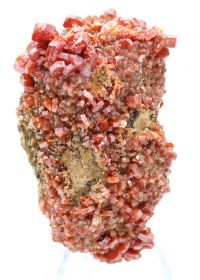

- Crystal system : Hexagonal
- Class : Phosphate minerals
- Colors : Red-orange to ruby red, yellow-brown
- Transparency : Translucent to opaque
- Luster : Resinous to adamantine
- Cleavage : Imperfect
- Trace : White to pale yellow
Origin and training
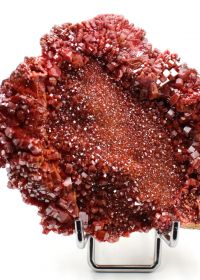

vanadinite forms in oxidation zones of lead deposits, particularly in arid or semi-arid regions. The formation process begins when primary lead-bearing minerals, such as galena (PbS), oxidize and react with vanadium-rich solutions. This process requires specific environmental conditions, including low water and an oxidizing environment.
The crystal structure of vanadinite is remarkable for its perfect hexagonal geometry. The crystals grow in a precise atomic arrangement where lead, vanadium, and chlorine ions are organized into a complex three-dimensional structure. This molecular organization explains the characteristic formation of hexagonal prisms and contributes to the mineral's unique physical properties.
Main deposits
vanadinite deposits are mainly distributed in arid regions of the globe:
Morocco :
- Mibladen Mine: Produces the finest collector's specimens
- Atlas: Bright red crystals of exceptional quality
- Taouz Mine: Remarkable specimens of crystals on matrix
UNITED STATES :
- Arizona: Historic deposits with bright orange crystals
- New Mexico: Specimens associated with geodes and druses
- Nevada: High purity raw crystals
Mexico:
- Chihuahua: Historic Discovery Site
- Zimapan: Remarkable prismatic crystals
Namibia:
- Berg Aukas Mine: Gem-quality specimens
- Tsumeb: Unique association with other rare minerals
Zambia:
- Broken Hill: Exceptional giant crystals
- Kabwe District: Prized Collectible Specimens
Properties and Uses
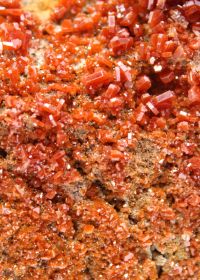

Collection :
- Specimens prized for crystals on matrix
- Museum pieces and private collections
- Sought-after specimens of raw stones and crystals
Jewelry and decoration:
- Creation of exclusive jewelry
- Use in pendants and Earrings
- Decorative objects and Ornaments
- Creation of prisms and Collectibles
Industry :
- Important source of vanadium
- Production of special steels
- Chemical catalyst
- Applications in metallurgy
Scientific applications:
- Study of oxidation processes
- Research in crystallography
- Development of new materials
History and mythology
Discovery and origin of the name
vanadinite is a mineral first discovered in 1801 by the Spanish mineralogist Andrés Manuel del Río.
However, it was confused with another mineral, lead chromate, and was not officially recognized until 1838 by the German mineralogist Friedrich Wöhler. The name "Vanadinite" comes from "Vanadium," a chemical element present in the mineral. vanadium was named after the Scandinavian goddess of beauty and fertility, Vanadis, because of the beautiful colors of its compounds.
Famous specimens
vanadinite is renowned for its distinctive hexagonal crystals that can range from red to brown.
The most famous specimens are the "Vanadinite on Barite" from Mibladen, Morocco. These specimens are particularly notable for their large red vanadinite crystals, which contrast sharply with the white barite on which they rest. Other notable specimens are the "Vanadinite on Galena" specimens discovered in Touissit, Morocco. These specimens feature bright red vanadinite crystals resting on a silvery galena matrix.
Historical significance
Historically, vanadinite played a crucial role as a source of lead.
Indeed, this mineral is one of the main ores of lead, a metal widely used in ancient times for the manufacture of water pipes, cosmetics, and paints. Furthermore, vanadinite is also an important source of vanadium, a chemical element used in the production of corrosion-resistant steel and superalloys. Thus, vanadinite not only has aesthetic value as a mineralogical specimen, but also has great industrial importance.
How to identify it
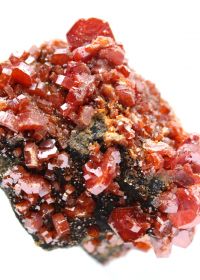

Identification methods:
Identification of the mineral vanadinite can be done by several methods.
First, visual examination is essential. vanadinite typically occurs as red to brown hexagonal crystals, often shiny. Observing these characteristics can provide an initial indication of the presence of vanadinite. Next, the mineral's hardness can be tested. vanadinite has a Mohs hardness of about 3 to 4, which means it can be scratched by a harder object, such as a knife. In addition, the density of vanadinite is quite high, about 6.9 to 7.2 g/cm3. Finally, chemical tests can be performed.
vanadinite is a lead and vanadium mineral, so when heated, it can produce a blue-green flame. Additionally, when placed in an acid, it can produce carbon dioxide bubbles. All of these methods combined can help accurately identify vanadinite.
Identification elements:
Crystalline form:
- Look for the characteristic hexagonal crystals
- Observe the termination of the crystals
- Check the regularity of the faces
Color and shine:
- Note the red-orange to ruby red color
- Observe the resinous to adamantine luster
- Check color consistency under different lighting
Physical tests:
- Check the hardness (scratchable with a fingernail)
- Note the weight is important for the size
- Observe the white to pale yellow trace
Mineral association:
- Identify typical accompanying minerals
- Observe the characteristic matrix
- Check the geological context
How to maintain it?
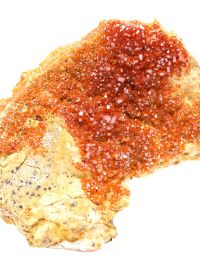

vanadinite is a delicate mineral that requires special care to maintain its beauty and shine. To begin with, it's important to keep it away from moisture and direct heat, as these conditions can damage its crystalline structure. It's best to store it in a cool, dry place away from direct sunlight.
When it comes to cleaning, it is recommended to avoid using harsh chemicals or solvents. Instead, use a soft, dry cloth to remove dust and debris. If a more thorough cleaning is needed, you can use a soft-bristled toothbrush and distilled water. Be sure to dry the vanadinite thoroughly after cleaning to prevent moisture damage. Finally, always handle your vanadinite with care to avoid scratching or damaging its fragile crystals.
Cleaning:
- Use only lukewarm demineralized water
- Avoid all chemicals
- Dry gently with a soft cloth
- Never use an ultrasonic cleaner
Protection:
- Store in a closed display case
- Avoid shocks and vibrations
- Protect from dust
- Maintain a stable temperature
Exposure :
- Avoid direct sunlight
- Favor LED lighting
- Maintain moderate humidity
- Regular rotation of exhibited specimens
Materials needed:
- Padded storage box
- Microfiber cloths
- Soft brush
- Demineralized water
- Cotton gloves
Conclusion
vanadinite, with its reddish hexagonal crystals and chemical composition rich in lead and vanadium, is a fascinating mineral. Its presence is often an indicator of lead and vanadium deposits, making it a valuable resource for the mining industry.
Its unique aesthetic and color also make it a favorite among mineral collectors. However, due to its lead content, vanadinite must be handled with care. vanadinite is a perfect example of the beauty and complexity that nature can offer, while also reminding us of the importance of caution and respect for our natural resources.
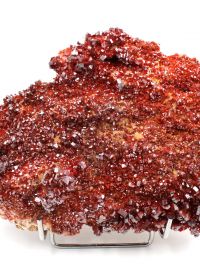
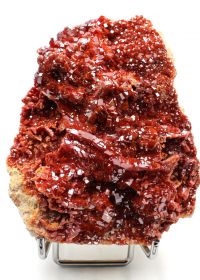
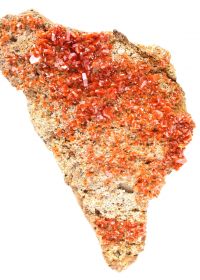
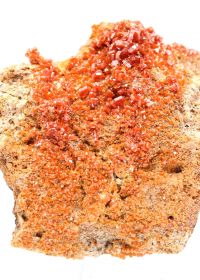
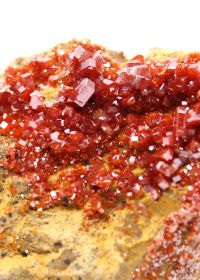
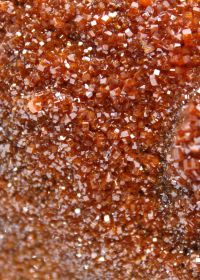


 vanadinite
vanadinite
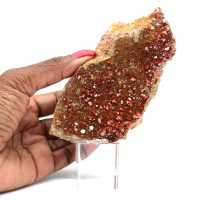
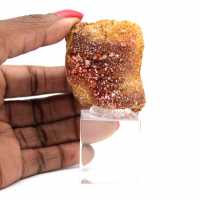
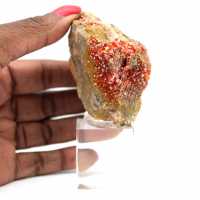
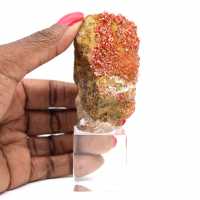
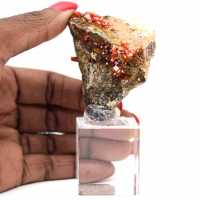
 mineraly.fr
mineraly.fr
 mineraly.co.uk
mineraly.co.uk
 mineraly.com.de
mineraly.com.de
 mineraly.it
mineraly.it
 mineraly.es
mineraly.es
 mineraly.nl
mineraly.nl
 mineraly.pt
mineraly.pt
 mineraly.se
mineraly.se





